The need is for a plant delivering 1 MW of power The soccer
The need is for a plant delivering 1 MW of power. The soccer field is used pretty much continually during the day, with many grown-up leagues during the night hours and many youth leagues in the earlier hours.
Given the fact that we are next to a River, it is reasonable to assume that water is an appropriate medium for the power plant. However, that the temperature in the river really should not increase by more than 1 degree C, to minimize the growth of algae.
Can you prepare a preliminary technical outline that outlining the main aspects of the proposed design? Can you also include the carbon footprint analysis, as well as the expected cost for running the plant for a full 24-hr day? Although the prices fluctuate, let’s assume that electricity is at $0.15/kW.h and natural gas at $1.30/therm.
Can you prepare a preliminary technical report outlining the main aspects of the proposed design Some additional technical details that you should keep in mind. Any turbine can have an isentropic efficiency of no more than 94%. Likewise any pump no more than 70%.
Solution
After studying the fundamental thermodynamic cycles of steam power plants and considering the characteristics and thermochemistry of fuels, it is appropriate to consider the design of the systems and flow processes that are operative in steam plants and other large-scale power production facilities. This chapter will focus first on the processing of several fundamental streams that play a major role in power plant operation. Up to this point, a great deal of attention has been focused on the water path from the point of view of the thermodynamics of the steam cycle. Additional aspects of the water path related to plant design are considered here. Another fundamental flow in the power plant, the gas stream, includes the intake of combustion air, the introduction of fuel to the air stream, the combustion process, combustion gas cooling in the furnace heat exchange sections, and processing and delivery of the gas stream to the atmosphere through a chimney or stack. A third important stream involves the transportation and preparation of fuel up to the point that it becomes part of the combustion gas. A major non-physical aspect of power production is the economics of power plant design and operation. This is considered in conjunction with some preliminary design analyses of a prototype plant. Environmental considerations also play an important part in planning and design. The chapter concludes with back-of-the-envelope type calculations that define the magnitudes of the flows in a large plant and identify major design aspects of steam power plants.
The Water Path
The Liquid-Water-to-Steam Path Several pumps are employed in the feedwater path of a steam power plant to push the working fluid through its cycle by progressively elevating the pressure of the water from the condenser to above the turbine throttle pressure. These pumps are usually driven by electric motors powered by electricity generated in the plant or by steam turbines powered by steam extracted from the main power cycle.
The power requirement of a pump is proportional to the liquid mass-flow rate and the pump work, as given by Equation , and inversely proportional to the pump efficiency:
Power = mvsat P/Efficiency of pump [ft-lbf /s | kW]
The pumps are required to overcome frictional pressure losses in water-flow and steam-flow passages, to provide for the pressure differences across turbines, and to elevate the liquid to its highest point in the steam generator. The pump power requirements are typically a small percentage of the gross power output of the plant. Thus condensate leaving the condenser passes through one or more pumps and feedwater heaters on its way to the steam generator. A typical shell-and-tube closed feedwater heater is shown . Normally, feedwater passes through the tubes while extracton steam enters at the top and condenses as it flows over the tubes to the bottom exit.
After passing through the chain of feedwater heaters and pumps, the feedwater enters the steam generator through the economizer. An economizer is a combustiongas-to-feedwater tubular heat exchanger that shares the gas path in a steam generator, as seen in. The economizer heats the feedwater by transferring to it some of the remaining energy from the cooled exhaust gas before the gas passes to the air heater, the pollution control equipment, and the stack.
Steam Generators
A two-drum steam generators in which the design vaporization pressure is below the critical pressure of water. Hot, subcooled liquid feedwater passes from the economizer and through the boiler tube walls to the drum loop located near the top of the steam generator. Liquid water circulates by free convection through the many boiler tubes between the drums until it is vaporized by the hot gas stream flowing over the tubes. A fixed liquid level is maintained in the upper steam drum, where the steam separates from the liquid and passes to the superheater. Solids settle in the bottom of the so-called ìmud drumî below it. A steam drum mounted on a railroad flat car en route to a construction site is The many stub tubes around the bottom and on top are to be 137 connected to steam-generating loops and to steam-superheating pipes, respectively, as seen at the top of The large pipes on the bottom and the ends are for connection to downcomers, which supply recirculated liquid water to various heating circuits in the steam generator. Steam produced in the steam drum, at a boiling temperature corresponding to the vapor pressure in the drum, passes to superheater tube or plate heat-exchanger banks. The superheater tube banks are located in the gas path upstream of the drum loop, taking advantage of the highest gas temperatures there to superheat the steam to throttle temperature. The hottest gases are used to heat the hottest water-tube banks, to minimize the irreversibility associated with the heat transfer through the large temperature differences between the combustion gas and the steam or liquid water. The dry steam from the superheater then passes from the steam generator through the main steam line to the HP turbine. The progression of tube banks, with decreasing water temperatures exposed to successively cooler gas temperatures from the secondary superheater to the economizer to the air heater are also seen in the universal-pressure (supercritical pressure) steam generator As the design throttle steam pressure increases toward the critical pressure of water, the density difference between liquid water and vapor decreases, finally vanishing at the critical point (3208.2 psia, 705.47°F.). As a consequence, in steamgenerator boiling loops, natural convection water circulationówhich is driven by the density difference between liquid and steamóbecomes impractical at pressures above about 2500 psia. Thus modern high-throttle-pressure power plants use circulating pumps to provide forced to circulation to augment or replace natural circulation of water in the steam generator. In single-drum steam generators, water flows downward from the steam drum through large pipes called downcomers located outside the furnace wall, then through circulating pumps to headers at the bottom of the steam generator. From the headers, water flows upward in vertical tubes forming the inside of the furnace walls. The water is heated by the furnace gases as it rises, and eventually boils and forms a two-phase flow that returns to the steam drum. There, vapor separates and passes to the superheater. Steam generators may utilize natural convection flow through downcomers and 139 vapor-laden upward flow through the tube walls alone or may combine natural convection with the use of booster pumps to provide adequate circulation for a wider range of operating loads. It is important to recognize that at the same time steam is being generated in the boiler, the tube walls are being cooled by the water. Adequate water circulation must be ensured to provide waterside heat transfer rates high enough to maintain tube wall temperatures below their limiting design values and thereby to avoid tube failure. A once-through supercritical steam generator, operates at a throttle pressure above the critical pressure of water as in the Riverside station discussed .There are no drums and no water recirculation in a once-through steam generator. Water from the economizer passes to the bottom of the furnace, where it starts its upward flow through the furnace tube walls. Steam formed in the tubes flows upward to be collected in headers and mixed to provide a unifrom feed to the superheater. The feedwater passes directly from the liquid to the vapor phase as it is heated at a pressure above the saturation pressure. It may be compared to a flow of water pumped through a highly heated tube with a downstream valve. The state of the steam emerging from the tube depends on the valve setting, the heat addition rate, and the feedwater flow rate. In the same way, the steam conditions at the turbine throttle may be adjusted by changing the turbine throttle valve setting, the fuel firing rate, and the feedwater flow rate. If the flow rate is decreased by closing the throttle valve, it is necessary to decrease the fuel firing rate to maintain the same thermodynamic conditions at the throttle. On the other hand, if the rate of heat transfer is increased without changing the flow rate, the steam discharge temperature will increase. Other adjustments, such as increasing condenser cooling-water flow rate, may then be appropriate to avoid an increase in condenser temperature and pressure. Similarly, an increase in fuel flow rate must be accompanied by an increase in air flow rate to maintain a constant air-fuel ratio. In cycles with reheat, the reduced-pressure steam from the HP turbines passes through the cold reheat line to the reheater section in the steam generator, where the steam temperature is returned to approximately the original throttle temperature. The steam then returns to the next turbine through the hot reheat steam line, indicates. After leaving the LP turbine, low-pressure steam then passes over the water-cooled tubes in the condenser and returns to the feedwater heating system as saturated liquid condensate. A condensate pump then raises the pressure of the liquid and transports it to the first low-pressure feedwater heater, where it begins another trip through the cycle. In order to avoid corrosion, scaling and the deposits of solids along the water path can result in losses of efficiency and unscheduled shutdowns, water of extreme purity is required in the steam cycle. Chemical and filtration processes are employed to ensure that high water quality is maintained, to avoid deterioration or clogging of water path components. An example of the potential deposits when proper water treatment is neglected . The deaerator, an open feedwater heater mentioned in 140 Chapter 2, provides for the removal of noncondensable gases, particularly oxygen, from the working fluid. The deaerator allows noncondensable gases to escape to the atmosphere through a vent condenser, while accompanying steam is retained by condensing it on cool surfaces and returning it to the feedwater heater stream by gravity flow. The turbine room at the Bull Run coal-burning power plant of the Tennessee Valley. Electrical generators are seen in the left and right foreground. Behind them, high-pressure turbines on the left are seen joined to low-pressure turbines on the right by two large, vee-shaped crossover steam lines. The side-by-side condensers are seen on either side of the low pressure turbines, a departure from the usual practice of locating the condenser below the low-pressure turbines.
The Condenser Cooling-Water Loop
The cooling loop, in which water passes through tubes in the condenser removing heat from the condensing steam, is an important water path in large steam plants. This cooling water, clearly separate from the working fluid, is usually discharged into a nearby body of water (a river, or a natural or man-made lake) or into the atmosphere. A typical wood-framed, induced-draft cooling tower used to dissipate heat from the condenser cooling water into the atmosphere. The tower is usually located a few hundred yards from a plant. Typically, the cooling water entering the tower is exposed to a flow of air created by upward-blowing fans at the bases of the funnels at the top of the towers. A fraction of the condenser cooling water, which passes over extensive aerating surfaces in the tower, evaporates and exits to the 141 atmosphere, cooling the rest of the water. The remaining chilled water is then returned to the condenser by a cooling-water circulating pump. A continuing supply of liquid makeup water is required for these towers to compensate for vapor loss to the atmosphere. In areas where large structures associated with power plants are acceptable, large natural-draft cooling towers may be used. A two large natural-draft hyperbolic cooling towers serving a large power plant. The height of these towers, which may reach over 500 feet, creates an upward draft due to the difference in density between the warm air in the tower and the cooler ambient air. Heat from the condenser cooling water warms the air, inducing an upward air flow through the heat transfer surfaces at the base. These towers offer long-term fan-power savings over mechanical draft towers. Under some conditions, these power savings may offset high construction costs of hyperbolic towers.
The Fuel Path for a Coal-Burning Plant
The supply and handling of fuel for a modern coal-burning power plant is a complex and expensive undertaking. In contrast to the relatively simple steady flow of fluid fuels in power plants that consume natural gas and fuel oil, solid-fuel-burning plants offer major and continuing challenges to engineers. The discussion here focuses on these operations and their challenges.
Getting the Coal to the Plant
The source of coal for a plant may be a surface mine or a deep underground mine. Power plants are sometimes located adjacent to mines, where conveyors may provide the only transportation required. This significantly reduces coal transportation costs which otherwise can be higher than the cost of the coal alone. Such plants are called mine-mouth plants. A mine-mouth plant may be an attractive option if its selection does not result in significant transmission costs to bring the electrical power to distant load centers where the utilitiesí customers are located. Today the power plant and coal mines are likely to be a considerable distance apart, perhaps a thousand miles or more. The most widely used modern transportation link between mine and plant is the unit train, a railroad train of about a hundred cars dedicated to transporting a bulk product such as coal. Although slurry pipelines (a slurry is a fluid mixture of solid lumps and liquid, usually water, which can be pumped through pipes by continuous motion) sometimes offer attractive technical solutions to coal transport problems, economic and political forces frequently dictate against their use. Dedicated truck transport is an occasional short-haul solution, and barges are sometimes used for water transport. Here, we will focus on unit trains. Several unit trains may operate continuously to supply a single plant. Trains carrying low-sulfur coal from Wyoming, Montana, and the Dakotas supply coal to plants as distant as Michigan, Illinois, and Oklahoma. This strange situation, in which utilities located in states with large quantities of coal purchase coal from distant states, was a response to pollution control requirements. It was preferred to purchase lowsulfur coal from a distant state rather than pay a high price for sulfur removal equipment perhaps 10% of the cost of the plant construction), some of which has a reputation for unreliability. In response to such choices, the Oklahoma legislature passed a law requiring utilities to burn at least 10% Oklahoma coal in their coal-burning steam generators. Such mixing of small quantities of high-sulfur coal with low-sulfur coal is an expedient to protect local businesses and to spread out resource utilization geographically. New plants, however, no longer have the option to choose low-sulfur coal or sulfur removal equipment. ìBest available control technology,î BACT, has become the rule. The Environmental Protection Agency now requires new plants to have scrubbers (sulfur removal equipment) even if the plants use low-sulfur coal, and they are required to employ the currently most effective pollution control technology.
Coal Unloading and Storage
On arrival at the plant, the unit train passes through an unloading station. Some coal cars have doors on the bottom that open and dump their load to a conveyor below. Others have couplings between cars that allow the rotation of individual cars about their coupling-to-coupling axis, by a dumping machine, without detachment from the train,. shows a breaker in the dumping facility that reduces large coal chunks to a smaller, more uniform size for transport on a belt conveyor. The under-track conveyor at the unloading station then carries the newly arrived coal up and out to a bunker or to a stacker-reclaimer in the coal yard. The stacker-reclaimer either feeds the coal through a crusher to the plant or adds it to the live storage pile. A permanent coal storage pile sufficient to supply the plant for several months is usually maintained. While the first-in-first-out approach common in handling perishable goods seems logical, a first-in-last-out storage system is usually used. A primary reason for this approach is the hazard and expense of coal pile fires, which can occur due to spontaneous combustion. Once a stable storage pile is achieved by packing and other treatment to restrict air acccess, it is usually not disturbed unless coal must be withdrawn by the stacker-reclaimer to satisfy unusual demands caused by labor strikes, extreme weather, rail accidents, or the like A conveyor transports coal from the reclaimer to a crusher house, where hammer mills, ball crushers, or roller crushers break up large chunks to a more manageable size. Another conveyor may then carry the crushed coal to one of several bunkers or silos for temporary storage prior to firing. Some of these features may be seen in the photograph of the PSO Northeastern .The rate of feeding coal from the silos is controlled to maintain the desired steam generator energy-release rate. In a pulverized-coal plant, the coal is fed from the silos to pulverizers, where it is further reduced in size to a powdery form. Warm air drawn through an air preheater in the steam generator by the primary air fan flows through the pulverizer, where it picks up the fine coal particles and transports them pneumatically through piping to the steam generator burners. Several arrangements of silos, feeders, pulverizers, and pneumatic transport systems
The Gas Path Fans
While natural or free convection may be used to provide combustion air to small boilers and heaters, modern power plants employ large fans or blowers to circulate air to the burners and to assist flue gas in escaping from the furnace. These fans are called forced-draft fans and induced-draft fans, respectively. A common arrangement of these fans is shown in Figure 4.4. Atmospheric air drawn into the steam generator by one or more forced-draft fans is heated as it passes through the cold gas side of an air heater on its way to the furnace. At the same time, combustion gases that have passed through the furnace heat transfer sections are cooled as they passed through the hot side of the air heater on their way to induced-draft fans and thence to the stack. In the case of pulverized-coal-burning plants, primary air fans.. supply enough pre-heated air to pulverizers to transport coal pneumatically to the burners. Primary air usually pre-heated to 300-600°F to dry the coal as it passes through the pulverizer. With a forced-draft fan alone, the furnace pressure is above atmospheric pressure, causing large outward forces on the furnace walls and a tendency for leakage of combustion gas from the furnace. On the other hand, the use of an induced-draft fan alone would cause the furnace pressure to be below atmospheric pressure, producing large inward forces on the walls and possible air leakage into the furnace. The forces on the walls, which can be significant, can be minimized by keeping the furnace pressure near atmospheric by using balanced draft, that is, the use of both forced- and induced-draft fans, which produce a gas path pressure distribution such as shown by the heavy line. In this design the forced-draft fan raises the pressure to 15 in. of water gauge entering the steam generator, and the induced-draft fan depresses its inlet pressure about 21 in. of water below atmospheric. As a result, the furnace inside-wall pressure is less than an inch of water below atmospheric. This substantially reduces both the potential for furnace leakage and the forces on the furnace walls.
The power requirements for fans may be determined in much the same way that pump power requirements are determined. Fans are primarily gas-moving devices that produce small pressure rises. Pressure and density changes across fans are usually small fractions of the fan inlet values. This justifies the approximation that the fan process is incompressible. Fan power requirements then closely follow the pump power prediction method discussed earlier. Thus, for a forced-draft fan, power may be estimated by using
PowerFD = Qair p air /Efficiency of fan [ft-lbf /s | kW]
For the induced-draft fan Power ID= densirty of air* Q air *pgas(1 + F/A)/ density of gas*Efficiency of fan [ft-lbf /s | kW]
where Qair is the volume flow rate of air entering the forced-draft fan. The second equation accounts for the additional fuel mass handled by the induced-draft fan and the
density of the gas leaving the furnace, assuming no leakage or diversion of air from that leaving the forced-draft fan , a centrifugal fan, air is spun by the rotor blades, producing tangential motion and pressure rise and leaving behind a vacuum for air to flow in along the axis of the fan. It the fan entrance is open to the atmosphere, its exhaust is pressurized; if its exhaust is atmospheric, its entrance pressure is below atmospheric. Fans typically do not produce large pressure rises but do produce large flows of gases. A diagram of an axial-flow fan designed for induced-draft use is presents a photo of the same type of fan. Induced-draft fans must be able to withstand high-temperature service and erosion due to airborne particulates. Large electrostatic precipitators located upstream of the induced-draft fans remove most of the flyash by inducing a static charge on the flowing particles and collecting them on plates of opposite charge. The plates are periodically rapped mechanically to free ash deposits that drop to the bottom of the precipitator and are collected and removed. Figure 2.1 shows electrostatic precipitators, to the right of the steam generator. The large structure behind the fans, air heater, and ducting and below the stack in is an electrostatic precipitator
Air Preheaters
The air leaving the forced-draft fan usually flows through an air preheater to a windbox around the furnace and then to the burners. A Ljungstrom rotary air preheater, used in many large plants,. The rotary air heater is a slowly rotating wheel with many axial-flow passages, having large surface area and heat capacity, through which air and flue gas pass in counterflow parallel to the wheel axis. When the wheel surfaces heated by the flue gas rotate to the air side, they are cooled by the air from the forced-draft fan. As result, the air temperature rises several hundred degrees before passing to the furnace windbox. Although the Ljungstrom rotary air heater is widely used in utility and industrial power plants, heat-pipe air and process heaters are now being considered and applied for use in power plants and industry. A heat pipe, is a sealed tube in which energy is transported from one end to the other by a thermally driven vapor. The heat-pipe working fluid absorbs heat and vaporizes at the lower, hot end. After rising to the higher, cold end, the vapor condenses, releasing its heat of vaporization, which is carried away by conduction and convection through external fins to the combustion air. The liquid then returns to the hot end by gravity and/or by capillary action through wicking, to complete the cycle. The wicking may be spiral grooves around the inside of the tube that ensure that the entire inside surface is wetted for maximum heat transfer. The wicking in the cold section is particularly important, because it provides increased surface area that increases inside-gas heat transfer rates. The outside the tube is usually finned to provide adequate external heat transfer rates, both from the flue gas and to the incoming air.
As a heat transfer device, a well-designed heat pipe has an effective thermal conductance many times that of a copper rod. Note that the energy transfer inside the heat pipe is essentially isothermal, since the liquid and the vapor are in near equilibrium. Although heat pipes will operate in a horizontal orientation, their effectiveness is augmented by gravity by inclining them about 5°ñ 10° to assist in liquid return to the hot end. In power plant air heater applications finned heat pipes supported by a central partition between the incoming air stream and the flue gas 153 stream are free to expand outward. This reduces thermal expansion problems and virtually eliminates the possibility of leakage between the flows. Such heaters often have been installed in process plants and have been retrofitted in power plants originally built without air heaters, because of their ease of installation and compact size compared with stationary tubular air heaters
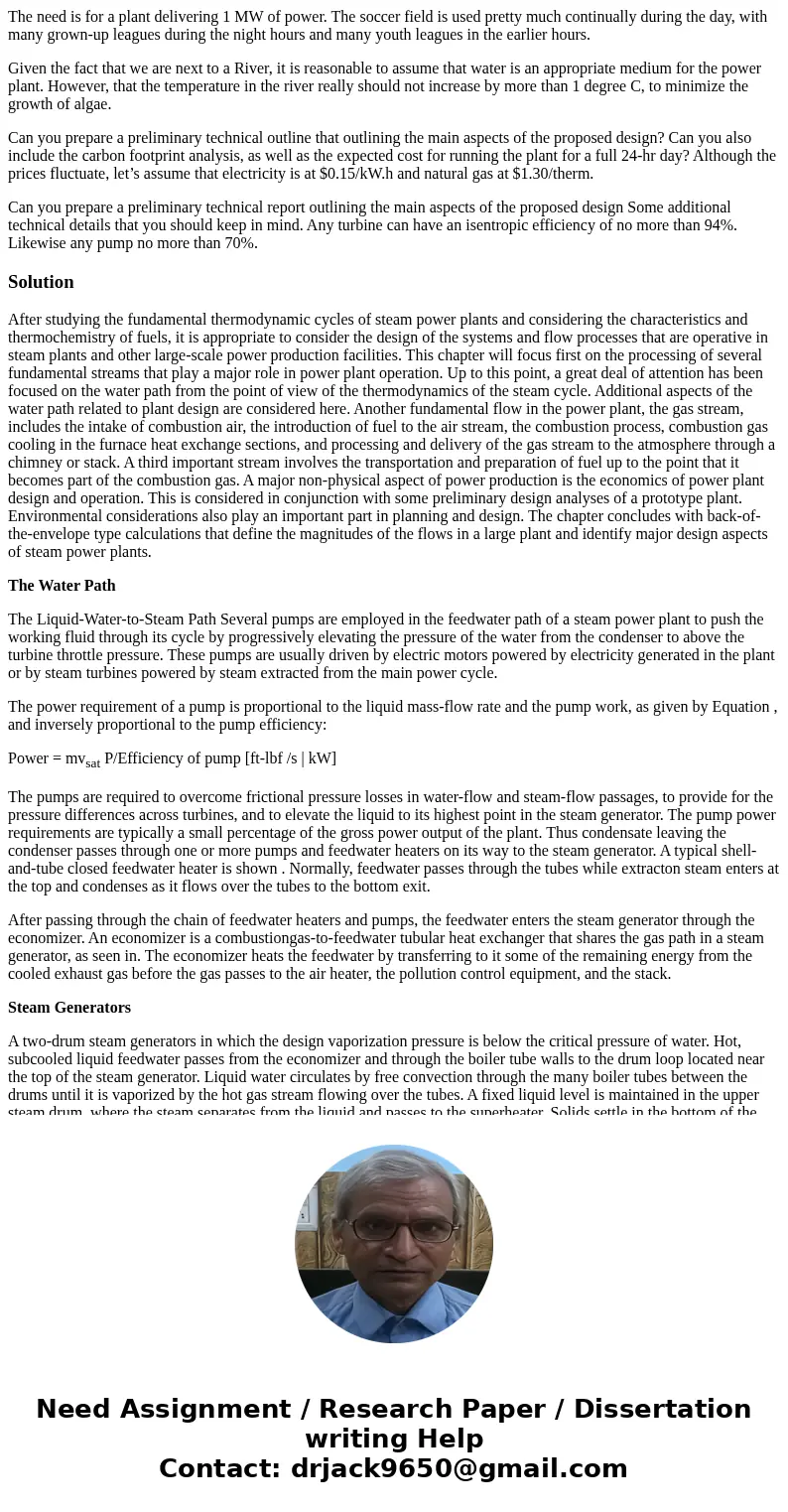
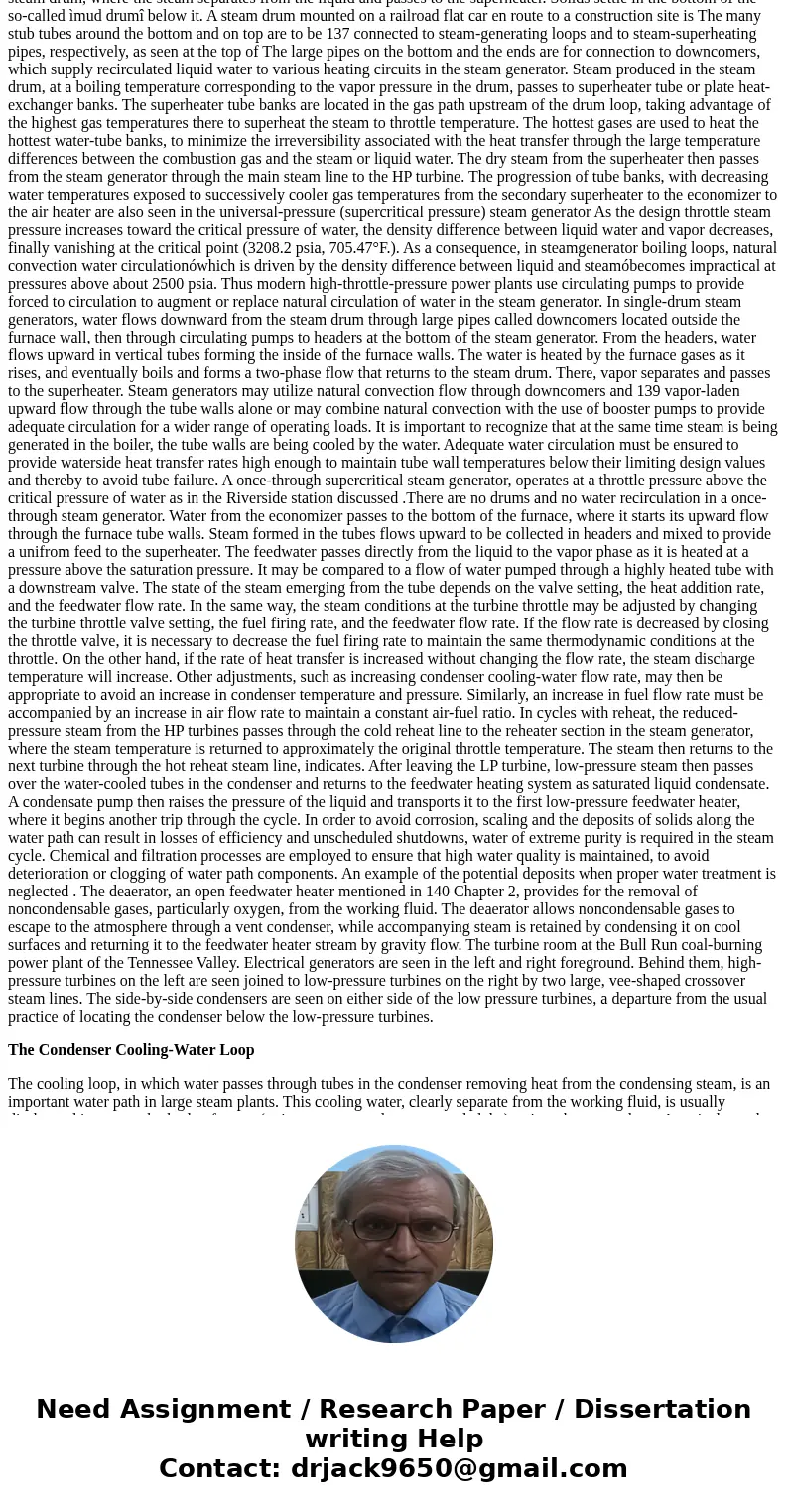
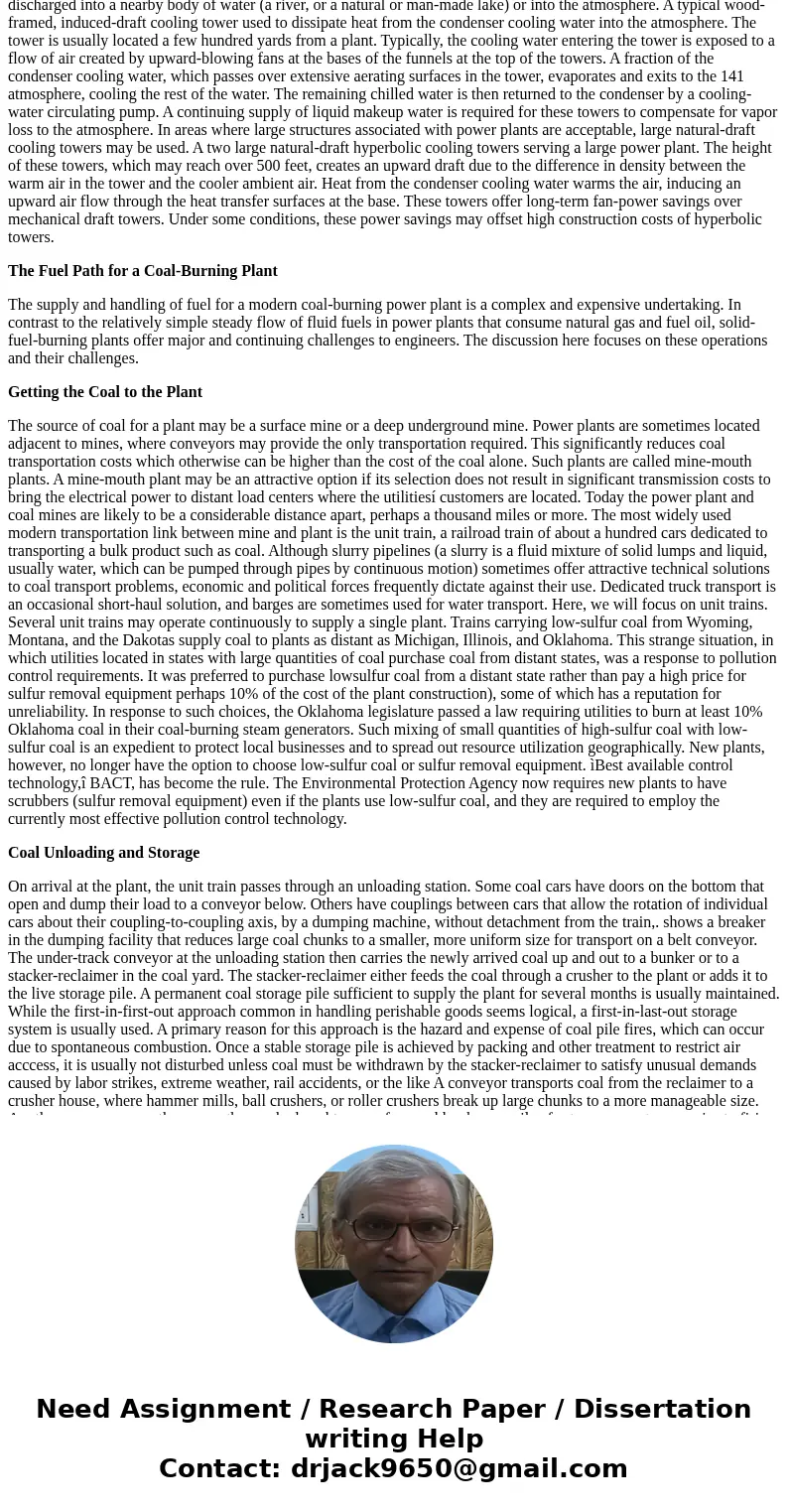
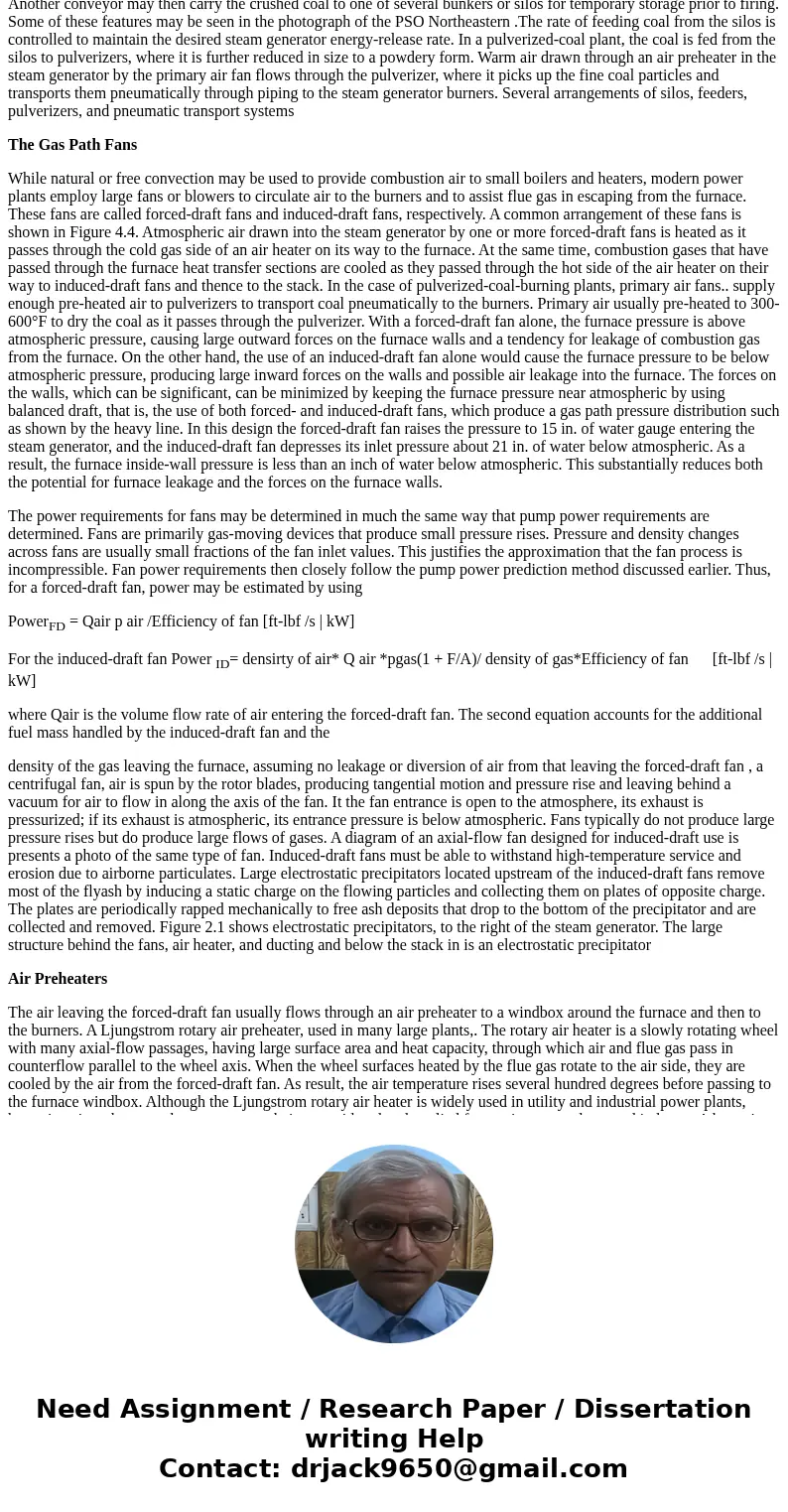
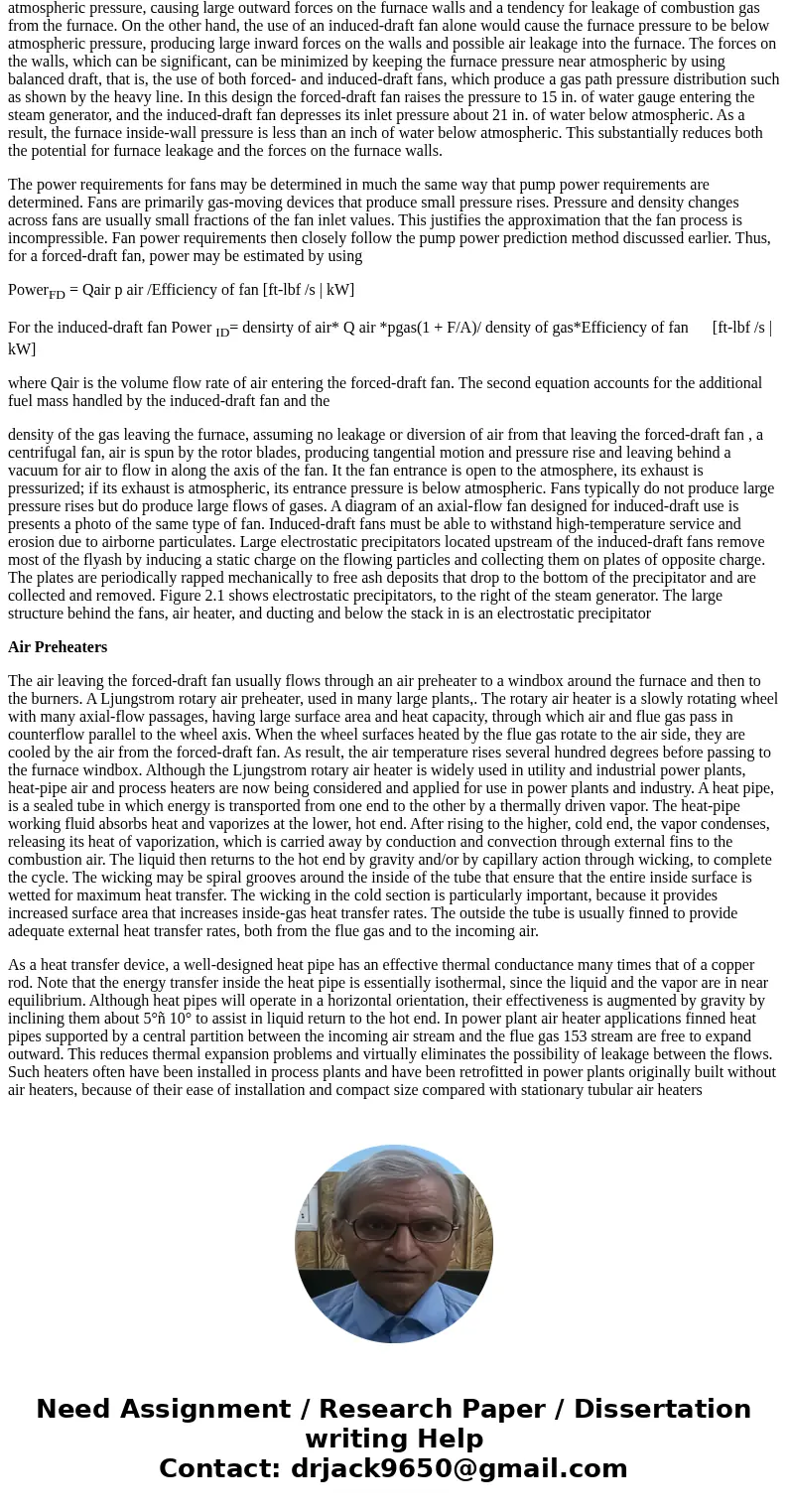
 Homework Sourse
Homework Sourse